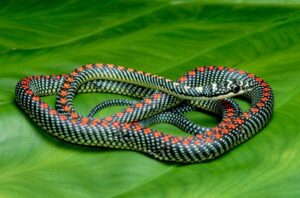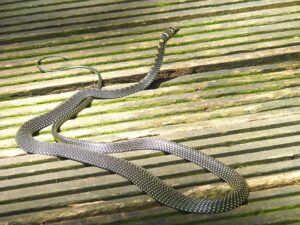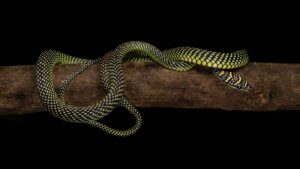The paradise flying snake (also called paradise tree snake) is a mildly venomous snake found in Southeastern Asia that can glide from the top of a tree.
The Latin and Greek word ‘Paradisi’ translates to ‘Park,’ where this snake was most probably discovered for the first time. The etymology of the word ‘Chrysopelea’ is unknown, but it most likely refers to a flying or gliding snake.
These diurnal snakes spend most of their time on tree canopies and rarely descend on the ground. They can jump from treetops by stretching their bodies, turning them into flattened strips with the help of their ribs. These snakes can cover a distance of over 300 feet with a single glide.
Scientific Classifications
- Suborder:Serpentes
- Family:Colubridae
- Genus:Chrysopelea
- Species:C. paradisi
Conservation Status
Subspecies
It has three subspecies:
- Chrysopelea paradisi celebensis
- Chrysopelea paradisi paradisi
- Chrysopelea paradisi variabilis
Description
Size
Their body length is 24–48 inches (61–122 cm). Females are larger than males.
Color and Appearance
The body color of these snakes is black, green, or yellow. They have red or orange diamond-shaped markings along their backs and a series of horizontal black strips on their head. They usually have solid greenish-yellow underbellies.
Paradise flying snakes have round black eyes and snub noses. Their eyes are larger than their head, and their tails are shorter than their body size. Their rear fangs are fixed to their jaw.
How Do They Fly
The kinematics of these snakes is unique. They fly differently from other flying animals as they do not have legs or wings. They take off in an anchored J-loop form, and once airborne, their cross-sectional body takes a triangular shape. Using an aerial undulation helps them to maximize the distance traveled.
Are They Dangerous to Humans
They are not harmful to humans because of their mildly toxic venom. Their tiny fangs do not inject venom when they bite; the venom only oozes into the wound and causes no severe infection.
A few humans were bitten on their fingers, but no ill effects were reported.
Paradise Flying Snakes at a Glance
Distribution
Paradise flying snakes live in more than ten countries, including Thailand, Indonesia, India, Malaysia, Cambodia, Philippines, Bangladesh, Singapore, and other parts of Southeast Asia.
Habitat
These snakes prefer moist and wooden habitats thanks to their arboreal nature. They mostly live in coconut palm trees and coastal forests where trees are close.
Most of the time, they are found around trees, under logs, or hiding in holes. However, they are adept climbers and often make their way up trees.
Lifespan
The life expectancy of paradise flying snakes is ten years.
Predators
Paradise flying snakes have no predators. No predators can catch them because of their tree habitation and gliding ability.
Diet
They are carnivores and mainly eat lizards and frogs. They are constrictors that can swallow their prey whole.
Reproduction
Not much is known about how these snakes reproduce. All that is known is that they are egg-laying species that can lay up to 11 eggs in one breeding season.
Care Sheet
Size of Enclosure: They require an enclosure that is 36 inches tall.
Substrate: These snakes require a substrate that can retain a lot of moisture without molding quickly. The best choice would be a 50/50 blend of organic sphagnum peat moss and vermiculite.
Humidity: They require a high humidity level in their enclosure.
Temperature: An overhead heat source is required to give them the heat they need. A UVB+ UVA basking bulb should be used in the daytime, and a thermostat is necessary to keep the heat output stable.
Feeding: House geckos and anoles should be their primary diet, while small rodents and button quail can be their occasional diet. Various species of hylids (tree frogs) can be included in their diet for variety.
Source
i.pinimg.com, indiabiodiversity.org, squarespace-cdn.com, thainationalparks.com









